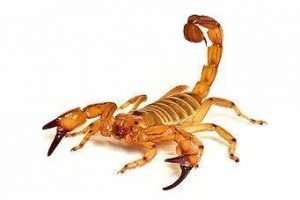Know how to identify Bark Scorpions! There are over 30 distinct species of scorpions in the Phoenix AZ Valley.
The most venomous scorpion is the Bark Scorpion. Extreme pain and swelling at the sting site, numbness, frothing in the mouth, and breathing difficulties can be brought by this scorpion’s venom. Severe medical complications or deaths are infrequent from Arizona bark scorpion stings or venom. In fact, according to the Mayo Clinic, so few fatalities or deaths from scorpion stings have been recorded in the United States.
Physical Identification

- Bark Scorpions have sender-like bodies built with shorter tails and pincers than other scorpion types.
- Two dark eyes at the top of the head, three sets of side-eyes at the top.
- Mature Bark Scorpions can grow to a size of 2.7 – 3.1 inches from head to the stinger.
- Body-color is brown, but it varies from all yellowish-brown with no marks to lines extending from head to tail. Right after Bark Scorpions molt, the color is darker yellowish, almost brown.
Identification of Behavior
Like Bark Scorpions, scorpions in Arizona live all year long and withstand the coldest temperatures in our desert. Bark Scorpions are the only scorpions able to co-exist with other common scorpions. In the winter months, Bark Scorpions assemble in the major groups to nest! Late Spring through late Summer in Phoenix is the Bark Scorpion Season.
Unless you’re a scientist, or you don’t have a convenient magnifying glass, the best way to say whether what you’ve got is a Bark Scorpion, by watching their actions. The Bark Scorpion will lay its tail down – parallel to the surface {but still curled up} while waiting for their food source or prey to come by. When the scorpion’s meal is motionless, the pincers will rip it apart. They are nocturnal predators, feeding on a wide range of insects, spiders, centipedes, and even other scorpions.
In reality, other scorpion species or type of scorpion in Phoenix, AZ, keep their tail up above their backs when relaxing. Will the scorpions crawl up the walls? Yeah, Bark Scorpions have the ability to scale up trees, stucco surfaces, block walls, internal walls, etc.} and also stay upside down.
Bark Scorpions are active at night, drawn to cold and wet areas, and have an airflow. That’s why Bark Scorpions prefer stone wall cracks, landscaping rocks, and inside your home for shelter. Expect a scorpion infestation if your property provides such perfect conditions. The scorpion cuticle fluoresces under ultraviolet light, i.e., blacklight or UV light, for reasons still unexplained.
Scorpion Guard Pest Control provides specialized Scorpion Pest Control in Mesa, Phoenix, Gilbert, Chandler, Scottsdale, AZ, and surrounding areas in North America.
Within homes, you can find bark scorpions in the following places:
- Stuck inside sinks and bathtubs in the mornings because they fell in the evening while hunting and can’t climb out.
- In dark parts of storage and closets.
- Ascending or hanging from walls or ceilings as they love climbing.
- In or on clothes, shoes, and other objects. When the sun comes out, scorpions look for cover and sometimes sting people who mistakenly put on clothes or shoes with a scorpion on them.
Outside, you can find bark scorpions in the following areas:
Bark Scorpions are nocturnal, so they can hide inside and under some things during the heat of the day to help prevent the loss of water.
- Within piles of rock or under huge rocks.
- In stacks of timber or tree bark and wood.
- Bark Scorpions love to hide in the cracks of concrete block walls.
- In concrete holes or cracks and concrete support beams.
- Within sprinkler boxes, since their favored foods, like roaches, spiders, and crickets, thrive.
The most prevalent Bark Scorpion species in the U.S. is Striped Bark Scorpion, not confused with Arizona Bark Scorpions. You can spot striped bark scorpions in Arkansas, Illinois, Colorado, Louisiana, Kansas, Mississippi, Missouri, Nebraska, Oklahoma, New Mexico, and Texas! Centruroides sculpturatus, or Arizona Bark Scorpions, is the most poisonous scorpion in the United States. Depending on the response of the victims, bites from Arizona Bark Scorpions are sometimes potentially fatal.


